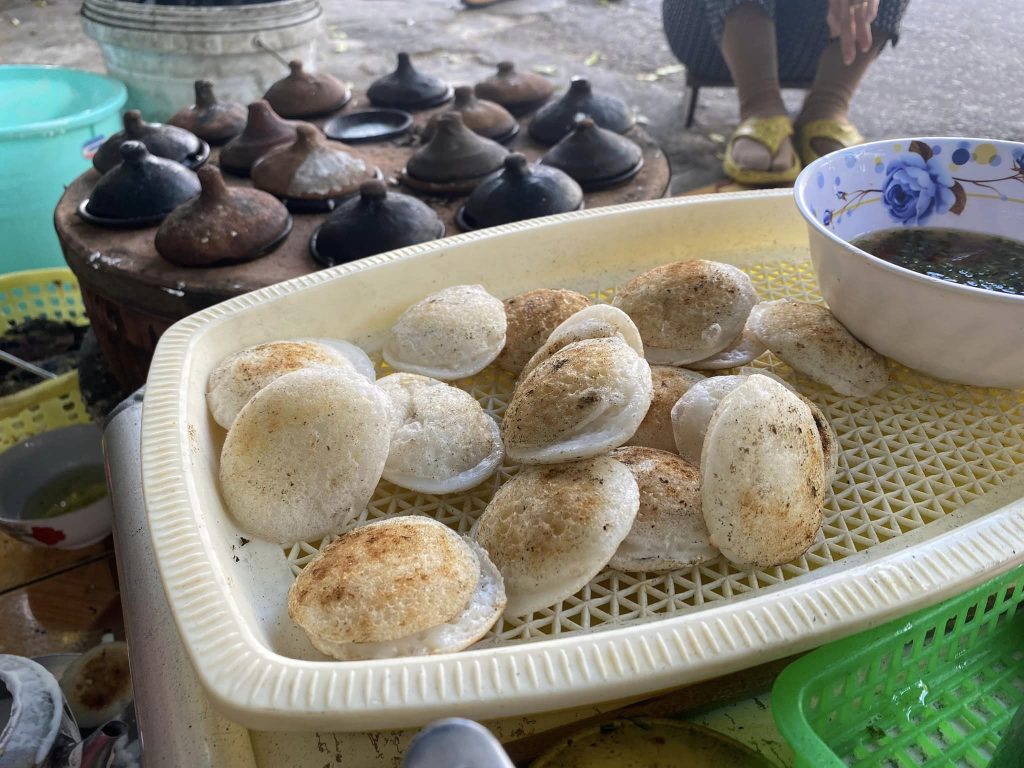Along the streets, alleys, and markets like Long Hải, Ngũ Phụng, and Tam Thanh on Phú Quý Island, visitors can easily come across a dish that looks like bánh khọt but is not bánh khọt — it’s bánh căn.
Many historical records mention that Phú Quý was originally part of the Champa Kingdom. The Cham people called it Koh-rong, and later the Vietnamese named it Cổ Long. It also had many other names: Thuận Tịnh, cù lao Khoai Xứ, cù lao Thu, the island of Nine Villages, and Phú Quý (Pulo Cecir de Mer). Due to limited documents, it is hypothesized that the Cham arrived here around the 15th–16th centuries, and the Vietnamese came around the late 16th to early 17th centuries.
Cuisine is a part of culture, and according to many locals, this dish originally came from a simple Cham recipe. Thus, bánh căn has been a common and familiar food on Phú Quý through many generations.
To make bánh căn, people soak regular rice then grind it into flour. Before grinding, a small amount of dried leftover rice is mixed in — a special local secret that helps make the bánh crispy. Like many other rice cakes, dry rice must be used because fresh or sticky rice causes the bánh to stick to the mold. Just the right amount of water is added to the batter; if too thin or thick, the bánh becomes mushy, undercooked, or burnt before fully cooking.
Since the early days of building the island district, most locals had to provide and make their own kitchen tools, including clay molds for bánh căn. Today, authentic bánh căn must be cooked in these clay molds — a type of kiln with a round top plate featuring many small circular holes, just the right size to place the small round bánh molds. These holes act as vents for heat to rise and cook the bánh.
Once the coals are hot and the molds heated, the skilled cook carefully pours the batter into the molds and covers them. When cooked, the bánh is gently removed and flipped onto another bánh. In this way, bánh căn here is not counted individually but by pairs, with two bánh pressed together. A perfect bánh căn is crispy on the outside, soft and spongy inside, with a pale golden crust that smells fragrant but is not burnt. To achieve this, the cook must carefully time the baking and immediately clean the mold for the next batch.
Starting from the original plain bánh căn, over time locals have created various fillings such as quail eggs, pork, shrimp, squid, and more to satisfy diverse tastes. When just cooked, a sprinkle of chopped green onions is added to make the bánh both fragrant and visually appealing. The white bánh, golden quail eggs, bright red shrimp, and fresh green onions create a truly distinctive dish. But what completes the experience is the dipping sauce.
The most unique is bánh căn served with fish sauce broth, common only in Ninh Thuận, Bình Thuận provinces, and Phú Quý Island. Small tuna or mackerel stewed in salty sauce provides the broth for dipping. You dip the bánh into the bowl of fish broth so it soaks in the flavor before eating. For those who don’t like fish broth, there is mắm nêm (fermented anchovy sauce) as an alternative. And if neither appeals, the traditional sweet and sour fish sauce with garlic and chili or crushed peanut dipping sauce is always available to try.
From a simple and rustic Cham dish, bánh căn today has been reinvented in many ways, making it diverse and appealing, becoming a unique culinary trademark that attracts tourists in every region.










